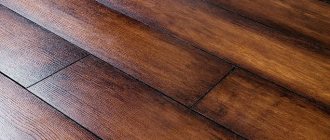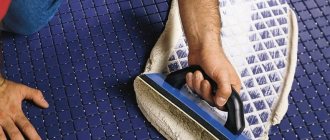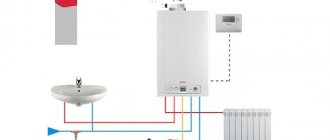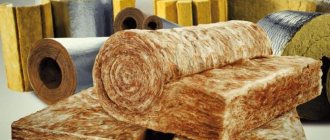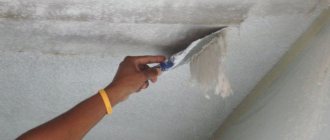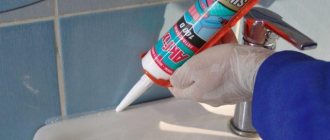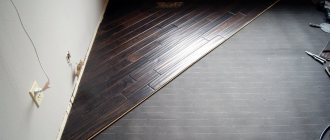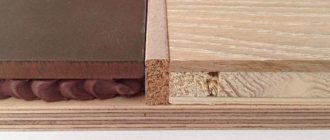Laminate is one of the most popular floor coverings; it is beautiful and durable, but even it has certain disadvantages. The fact is that laminate is afraid of water and upon contact with it loses its appearance and shape. Another drawback of the material is the appearance of squeaking. In order to protect the coating from damage, it is necessary to lay it correctly, carefully covering all cracks and joints. This is especially true for low-quality laminate, which itself is short-lived, and is also more susceptible to moisture than others. Additionally, sealant for laminate flooring will help protect the joints between the planks of the covering.
Laminate sealant
Why do you need sealant?
Laminate is a type of flooring that consists of small planks made from wood fiber board. The very name of the material - laminate - directly indicates that this material is layered and consists of a load-bearing layer, a decorative layer that gives color to the material, and a protective top layer made of acrylic or melamine resin. It is the last layer that protects the laminate from premature swelling and deterioration.
Why use laminate sealant?
During installation, the laminate planks are tightly connected to each other using special locks. However, the top layer will not 100% protect the material from moisture. Water that gets on the floor in large quantities can easily seep into the area of the slat locks, as well as penetrate inside the lamella itself. Liquid can cause damage to the laminate, as it reacts very sharply to its influence and is severely deformed.
Moisture poses a great danger to laminate flooring
On a note! In case of flooding of a living space, with a 99% probability, the laminate flooring will have to be completely replaced.
Laminate sealant is necessary to further protect the material from getting wet. It is not afraid of exposure to water and will not allow it to have a negative impact on the coating. The sealant will perfectly protect all the interlocking joints of the coating, which will significantly extend the service life of the laminate. All areas treated with the substance will be very tightly connected, which will allow them to withstand heavy loads.
Applying sealant
Important! Using a laminate sealant will not have a negative impact on the material during the entire period of use. Neither the operational nor decorative characteristics of the floor covering will change.
Laminate sealant does not affect the performance of the coating
However, there is no point in using sealant everywhere when installing laminate flooring - it is enough to use it only in those rooms where there is high air humidity. In living rooms that are regularly ventilated and not constantly exposed to damp air, this substance does not need to be used. But even where it is excessively dry, sealants will help protect the coating from drying out and deformation.
Example of joints sealed with sealant
sealant for laminate
How to fix defects
Removal of swollen lamellas can be carried out without disassembling the row to achieve positive results. If the swelling occurs in a small area, you need to dismantle the floor covering and replace the damaged slats with new ones.
If the panels are swollen due to temperature changes, this problem is resolved as follows.
- We remove the baseboards.
- We take out the outer slats.
- We cut the edge with a hacksaw.
- We carefully place the cut lamellas in their original place.
- We install skirting boards.
After a few days, the “behaved” material should return.
The problem of bloating can be corrected in several ways. It depends on the reasons for their occurrence
If the material is swollen from moisture, you must:
- remove furniture from the room;
- open the windows and let the panels dry;
- You can try drying them with a hairdryer. It takes 3-5 days to dry the laminate.
If it was not possible to eliminate the defects in this way.
- Remove the damaged area. In this case, number the boards on the wrong side.
- Remove moisture from the base and leave the floors disassembled for 5 days.
- Remove any mold or damage that appears. Treat the lock joints with wax or oil.
- Place the slats in place according to their numbering.
- If the slats are completely damaged, replace them with new ones.
To avoid such problems, purchase high-quality and proven material. To do this, you will have to study its technical characteristics and reviews from previous customers. Be sure to lay the material only on a carefully prepared base with thick plastic film. Do not forget to leave gaps between the walls and slats of at least 1.2-2 cm. Treat all joints and interlocking joints with impregnations or water-repellent compounds.
To avoid such problems, you need to choose quality material
A little about the composition of the product
Sealants can be produced on the basis of acrylic or silicone, to which various coloring, plasticizing and other components are added:
- fungicides and antiseptics that protect against mold and mildew;
- chalk, quartz flour and other mechanical components;
- organic extenders, which reduce the viscosity of the substance;
- pigments that give the sealant a certain color.
Colored sealant for laminate
On a note! At home, sealants cannot be painted. Therefore, it is important to purchase sealant immediately matching the specific color of the material.
Using laminate sealant
The composition requirements for laminate sealant are as follows:
- the absence of substances that negatively affect the human body;
- ease of removal from surfaces, which will allow you to easily remove excess substance from the surface even at the initial stage of hardening;
- the substances in the sealant should not glue the lamellas very tightly to each other.
Rico Protect Click Sealant
Another use of Bostik
Laminate flooring used in the 2000s had a conventional adhesive lock. At that time, we assembled floating floors using Dutch Forbo glue based on dehydrated PVA. The idea is to use Bostik or Moment glue to glue the lock in order to improve the adhesion of the planks to each other. The work is labor-intensive, but if you have the desire and ability to do it yourself, this information may come in handy.
Properties and characteristics of laminate sealant
Unlike compounds not intended for processing laminate, the sealant does not glue individual laminate strips together, so it cannot be called glue. It rather resembles a kind of elastic seal. However, many of its properties directly depend on its composition.
Sealant for laminate homax Сlick
Main characteristics of the sealant:
- elasticity , but at the same time strength and durability, resistance to various external influences;
- ability to withstand moisture and temperature changes;
- is possible to hide the cracks and joints between the laminate planks so that water does not penetrate there;
- ease of application at home - no complex equipment is needed (maximum - the sealant itself and a mounting gun);
- the possibility of dismantling the laminate if necessary - the sealant will not glue individual lamellas together;
- ease of removal of excess product;
- safety for human health under any operating conditions;
- invisibility on the floor surface;
- additional sound insulation properties.
There are many benefits to using laminate sealant.
On a note! As a rule, in expensive and high-quality laminate, the joints between the lamellas have a special coating, and therefore sealant may not be used for such material.
It must be remembered that for laminate it is worth purchasing a specialized sealant. Conventional sealing compounds used in other areas are not suitable for these purposes.
Bostik Clic Protect laminate sealant
Main manufacturing companies
The main manufacturers of laminate sealant include the following companies:
- Masterfix (Russia).
- Bostik (USA).
- Clic Protect (France), etc.
It makes no sense to publish a complete list of manufacturers, since the selection criterion should be the properties of the material, its composition and other parameters, but not the name of the company.
Laminate sealants
All sealants produced by various manufacturing companies, depending on the composition, can be divided into two categories - acrylic and silicone. They differ in operational properties and some characteristics.
Using sealant when laying laminate flooring
Silicone sealants
The name of the category speaks for itself: in the composition of the sealants included in it, the obligatory base is silicone - an organosilicon chemical substance that has found its way into many areas of human life.
Silicone-based sealants are characterized by high elasticity and good adhesion, while they are also very durable. These products are safe for human health, do not leave stains during operation, are not afraid of temperature changes and are very easy to use.
Silicone sealant for laminate
On a note! Sealants belonging to this group are used most often. The main areas of application are sealing joints and cracks, protecting the coating from moisture.
Acrylic sealants
Here the composition is based on acrylic - a synthetic polymer. These sealants provide a strong connection that remains flexible and does not allow moisture to get under the coating and ruin it. This sealant can also be used to mask minor coating defects and does not crack throughout the entire period of operation. Interestingly, seams treated with acrylic do not turn yellow, which means the floors will look like new.
Acrylic sealant can be easily processed using regular sandpaper. It can be coated with various primers and paints
Acrylic sealant contains no silicone or polyester substances, which increases its value from an environmental point of view. Sealants will not harm either people or pets living in the house.
Application of acrylic sealant
Advice! Acrylic sealants are rarely colorless - they almost always contain dyes. Therefore, when choosing a sealant by color, it is important to have with you a sample of the laminate for which the substance will be used.
Total
The flooring market offers a wide range of different types of products for processing laminate joints:
- Sealant gels;
- Silicone sealants;
- Acrylic sealants;
- Wax compounds;
- Mastics;
- Grout;
- Liquid plug.
Each composition has its own advantages and disadvantages, which characterize the area of its application. Some are more universal, others have a narrow focus. You can choose the right sealant for laminate flooring only based on the specific conditions of use.
Most popular brands
The selection of sealants on store shelves today is amazing. The product can be selected in any price category, for any laminate color and with different application requirements. A review of popular products will help you choose the best and most suitable sealant.
Table. Popular sealants for laminate flooring .
| Name | Characteristic |
| Click Guard | A German sealant that is used quite often and has very good reviews. Suitable for processing absolutely any laminate - expensive and cheap - as well as parquet. It is convenient to use, as it is sold in tubes with a tip and does not require special devices. The disadvantage is the high price. The substance polymerizes in just 15 minutes, then excess composition is easily removed. Consumption – 1 package per 8 sq. m. |
| Soudal | Acrylic colored sealant, suitable for sealing cracks and restoring chips/scratches. It does not have an unpleasant odor, but has excellent adhesive properties. Excess can be washed off with water. The product can only be used with a specially designed gun, which is a disadvantage of the product. |
| Masterfix | The sealant is made in Russia, and therefore has a low price and good quality. It is universal and has excellent water-repellent properties. Ideal for non-professional use. |
| Rico AquaStop | A composition that is made on the basis of natural wax. Perfectly protects laminate planks from moisture. Apply with a brush. |
| Click Protect | Swedish sealant, colorless. Polymerization time – 30 minutes. Economical consumption - only 1 package per 15 sq. m. Recommended for use during laminate installation. The disadvantage is the high price. |
Click Protect sealant
ClickGuard. A series of German sealants that are distinguished by the highest performance indicators, therefore they are considered one of the best on the modern market
Choosing a sealant for laminate
Not all popular sealants are described above - there are a lot of them on store shelves. It is clear that making the right choice is very difficult, especially for a beginner in the field of laminate installation. What should you consider when choosing a sealant for laminate flooring?
- First of all, the quality of the product is determined. It is worth remembering that the price-quality ratio is not always adequate. It happens that even expensive remedies turn out to be far from the best. Reviews from those who have already used one or another sealant will help you determine the quality of the product.
Elastic sealant Homax Click
- Composition is also an indicator of quality. In addition, attention is drawn to the presence of substances in the sealant that emit an unpleasant odor and are harmful to health. Among the variety of products, there are also those that do not emit a smell at all.
- Timing of work. It is better to take a sealant that has a short polymerization time and complete drying.
- The method of application is also worth evaluating, because for some products you need to buy special equipment, for others you don’t have to buy anything.
- Price is also an important indicator. The budget must be assessed, because several packages of the product may be needed to treat laminate flooring in a room.
Elastic sealant Homax Click
Professional laminate installation
Using laminate sealant
Laminate flooring is usually sealed in two cases - if a new coating is being laid and if the old one is being restored.
Attention! In the second case, after the laminate is disassembled, it is important to remove the old sealant, if any, from the ends of the lamellas. A spatula or a special solvent will help remove the substance. The main thing is to carry out the actions carefully so as not to damage the locks of the laminate.
Then you can begin sealing the seams while laying the laminate.
Step 1. The surfaces where the sealant will be applied, that is, the ends of the lamellas, are cleaned of debris and dust.
First, the surfaces must be thoroughly cleaned.
Step 2. Next, the sealant is applied in an even layer to the upper part of the end.
Applying sealant
Step 3. Immediately, before the sealant has hardened, the lamella is inserted with its end into the groove of the lamella of the previous row and snaps into place with careful pressure.
The slats are connected
Step 4. The sealant is also applied to the side of the laminate panel.
Carefully apply the sealant
Step 5. Excess sealant is removed from the surface of the laminate after approximately 20-30 minutes.
Extruded sealant
Removing excess sealant
Video - Sealing laminate
Sealing the deformation gap
Using sealant, you can also seal expansion joints. They must remain along the walls after installing the laminate, but can pose some threat to the material, allowing moisture to penetrate into the coating.
Laying laminate flooring with sealant
Step 1. Using a slightly damp cloth, treat the working surface of the laminate - the place that is very close to the wall.
Cleaning the work surface
Step 2. Painting tape is glued along the deformation gap so that the sealant gets only into the seam, but not onto the surface of the laminate.
Applying masking tape
Step 3. The seam is evenly filled with sealant.
Filling the seam with sealant
Step 4. Using a small rubber spatula, smooth out the sealant. It is important to carry out this procedure in the first 10 minutes after applying the substance.
The sealant is leveled with a spatula
Step 5. The masking tape is removed from the surface of the laminate.
Removing masking tape
Step 6. The surface of the sealant is carefully wiped with a damp cloth.
The sealant is wiped with a damp cloth
What should I do to prevent cracks from appearing?
- Vacuum regularly. If dirt particles do not clog into the gaps, they will perform their functions - they will prevent deformation of the boards.
- When liquid is spilled, immediately wipe the floor with a soft cloth. Moisture will not seep between the boards and will not be absorbed.
- Do not move heavy furniture across unprotected floors. In case of rearrangements, keep walkways and rugs made of soft, dense materials on hand. Lay them so as not to catch the joints of the boards with furniture legs.
- If a gap appears, seal it immediately. Minor deformation can be easily corrected using sealant or grout. These compounds will prevent further development of the problem.

